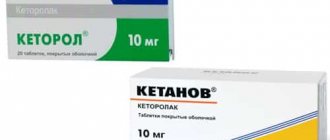Ketanov®
The classification of side effects is presented: often - 1-10%; infrequently - 0.1-1%; rarely - 0.01-0.1%; very rarely - less than 0.001%, including isolated cases.
From the digestive system: often (especially in elderly patients over 65 years of age with a history of erosive and ulcerative lesions of the gastrointestinal tract) - gastralgia, diarrhea; infrequently - stomatitis, flatulence, constipation, vomiting, feeling of fullness of the stomach; rarely - nausea, erosive and ulcerative lesions of the gastrointestinal tract (including with perforation and/or bleeding - abdominal pain, spasm or burning in the epigastric region, melena, vomiting like “coffee grounds”, nausea, heartburn, etc. .), cholestatic jaundice, hepatitis, hepatomegaly, acute pancreatitis.
From the urinary system: rarely - acute renal failure, lower back pain with or without hematuria and/or azotemia, hemolytic uremic syndrome (hemolytic anemia, renal failure, thrombocytopenia, purpura), frequent urination, increased or decreased urine volume, nephritis, edema renal origin.
From the senses: rarely - hearing loss, ringing in the ears, visual impairment (including blurred visual perception).
From the respiratory system: rarely - bronchospasm or dyspnea, rhinitis, laryngeal edema (shortness of breath, difficulty breathing).
From the side of the central nervous system: often - headache, dizziness, drowsiness; rarely - aseptic meningitis (fever, severe headache, convulsions, stiffness of the neck and/or back muscles), hyperactivity (mood changes, anxiety), hallucinations, depression, psychosis.
From the cardiovascular system: infrequently - increased blood pressure; rarely - pulmonary edema, fainting.
From the hematopoietic organs: rarely - anemia, eosinophilia, leukopenia.
From the hemostasis system: rarely - bleeding from a postoperative wound, nosebleeds, rectal bleeding.
From the skin: uncommon - skin rash (including maculopapular rash), purpura; rarely - exfoliative dermatitis (fever with or without chills, redness, thickening or peeling of the skin, swelling and/or tenderness of the tonsils), urticaria, Stevens-Johnson syndrome, Lyell's syndrome.
Allergic reactions: rarely - anaphylaxis or anaphylactoid reactions (change in facial skin color, skin rash, urticaria, itching of the skin, tachypnea or dyspnea, swelling of the eyelids, periorbital edema, shortness of breath, difficulty breathing, heaviness in the chest, wheezing).
Other: often - swelling (face, legs, ankles, fingers, feet, weight gain); less often - increased sweating; rarely - swelling of the tongue, fever.
What kind of drug is this?
The drug "Ketanov" helps people with headaches very quickly and well. But it is better to use it in the case when a serious traumatic brain injury has been received, which causes severe pain, and in other more standard situations it is best to use analgin.
There are a lot of jokes about this drug among doctors because of its name. Patients easily remember it because the name of the drug is similar to their last name. In fact, it is an extremely powerful pain reliever. Its influence on the body is carried out at the deepest level. The medicine blocks the production of acids, which trigger the processes of pain, inflammation and heat.
"Ketanov" is taken very often for headaches.
Ketanov in the treatment of chronic pain syndrome in cancer patients
Key words: NSAIDs, Ketanov, cancer patients, treatment of chronic pain syndrome, bone metastases, primary malignant tumors involving bones.
Nonsteroidal anti-inflammatory drugs (NSAIDs) have been and will undoubtedly remain the main symptomatic treatment of pain used in real-life clinical practice in the coming years. Representatives of many medical specialties are interested in these drugs. After all, pain is the most painful and frequent manifestation of most diseases and pathological conditions, and its fastest and most effective relief is traditionally one of the priority tasks of medicine [1,2]. NSAIDs demonstrate good analgesic potential for both acute and chronic pain, which allows them to be successfully used as monotherapy in combination with painkillers from other drug groups. In addition, NSAIDs have anti-inflammatory and antipyretic effects; This combination of properties is especially valuable. Therefore, NSAIDs are used extremely widely and do not lose their importance, despite the introduction into clinical practice of new, revolutionary approaches to treatment [1–4]. However, serious limitations on the widespread use of NSAIDs in clinical practice are their ability to cause ulcerative-erosive damage to the gastrointestinal mucosa. The need for symptomatic drugs has remained almost the same. And if in 1997 47.3% of patients received NSAIDs, then in 2007 – slightly less than 44.7%. At the same time, the number of consumers of analgesics of other classes increased – from 7.5 to 11.4%. This paradox - the need for widespread use of NSAIDs even against the backdrop of the most modern methods of pathogenetic therapy - is due to the fact that the level of pain in patients with rheumatoid arthritis (RA) has not actually changed over 10 years. If in 1997 the average score for the severity of pain was 4.7 points on the visual analogue scale (VAS), then in 2007 it was 4.5 points. At the same time, severe pain (7–10 points) was observed in 27.6 and 23.2% of patients, respectively [4]. The popularity of NSAIDs stimulates the activity of pharmaceutical companies that actively promote their products. Its result was a real abundance of various representatives of this medicinal class on the domestic pharmacological market. Thus, 16 international non-proprietary names of NSAIDs are registered in our country: aceclofenac, diclofenac, ibuprofen, ketorolac, ketoprofen, lornoxicam, meloxicam, metamizole, naproxen, nimesulide, piroxicam, tenoxicam, phenylbutazone, flubiprofen, celecoxib, etoricoxib. Moreover, many of these drugs have several generics, and diclofenac has about 100. Such a variety of representatives of one drug group creates considerable difficulties for practicing doctors. Today, doctors receive an excess of information about these drugs, and the information is mainly of an advertising nature, completely heterogeneous and often biased. This makes it extremely difficult to select a specific drug - after all, the choice of drug should be based primarily on clear, well-founded data indicating its beneficial properties and existing disadvantages. There is an urgent need to use uniform, standard approaches to assessing the clinical merits of NSAIDs, and above all this concerns the comparison of the safety of various representatives of this drug group. After all, it is well known that the effectiveness of various representatives of NSAIDs, if they are used in standard anti-inflammatory doses, is approximately the same. Therefore, the fundamental difference between these drugs is determined by the risk of developing drug complications. With the progression of malignant tumors, severe pain syndrome occurs in 60–80% of patients, which requires regular use of analgesics. The use of opioids in clinical practice was the first attempt to prescribe drugs that relieve severe pain, regardless of their pathogenesis, due to the presence of a pronounced analgesic effect. However, given a number of undesirable side reactions (impaired functions of the respiratory center, nausea, vomiting, constipation, drug dependence, etc.), opioids are not widely used in the treatment of chronic pain. At the end of the 80s of the twentieth century, the situation changed dramatically due to the introduction of NSAIDs into clinical practice, one of the representatives of which is Ketanov - a new peripheral analgesic that combines such properties as: 1) high analgesic activity, equal in severity to drugs opioid type; 2) high safety due to the absence of adverse reactions characteristic of narcotic analgesics; 3) prolonged action; 4) it is possible to use the drug both orally and parenterally. The active ingredient of the drug Ketanov is ketorolac tromethamine, a pyrrole-substituted derivative of arylacetylic acid. Ketanov is produced pharmaceutically both in tablet form and in ampoules. Each film-coated tablet of Ketanov contains ketorolac tromethamine 10 mg. Each 1 ml ampoule of Ketanov for injection contains ketorolac tromethamine 30 mg. The drug Ketanov carries out its clinical effect by suppressing the synthesis of cyclooxygenase enzymes, as a result of which the production of prostaglandins, which are mediators of pain sensitivity, is suppressed. The drug does not bind to opioid receptors and therefore does not have side effects on the central nervous system, including a depressant effect on the respiratory center and does not reduce the contractile activity of smooth muscles. The analgesic effect of the drug Ketanov exceeds in severity its anti-inflammatory, antipyretic and aggregation effects on platelets. The purpose of this work is to evaluate the analgesic effect and safety of the drug Ketanov in the treatment of chronic pain in cancer patients. The study was conducted with the participation of 28 patients with different localizations of the tumor process, confirmed by histological examination. The age of the patients ranged from 19 years to 61 years. There were 16 (57.1%) men, 12 (42.9%) women. None of the patients received narcotic drugs before inclusion in the study protocol. All patients had an unfavorable life prognosis at the start of the study. All patients suffered from pain of varying localization, intensity and duration (Tables 1 and 2). The majority of patients (22 people, 78.5%) had stage IV tumor process, of which metastases to the skeletal bones were observed in 9 (32.1%), primary bone tumors were detected in 5 patients (17.8%). During this study, 4 patients (14.2%) received antitumor drug treatment, 3 patients (10.7%) received radiation therapy. The patient included in the study protocol independently documented the intensity of pain on a daily basis using a visual analogue scale (VAS) and noted the additional medications taken. If it was necessary to change the dose of Ketanov or if other medical situations arose during treatment, consultations were carried out by telephone. The duration of pain ranged from 3 weeks to 6 months. The average pain intensity was 2.8 ± 0.74 points according to VAS. The drug Ketanov was prescribed both orally and parenterally. The size of a single dose depended on the intensity of the pain syndrome and was 10–20 mg for moderate pain, 20–40 mg for moderate intensity and 30–60 mg for severe pain. Pain relief occurred within 30–50 minutes. from the start of taking the drug and lasted 4–5 hours when administered orally. The drug was prescribed parenterally, as a rule, to relieve severe pain at a dose of 30–60 mg every 15–20 minutes. The patients felt obvious relief, which lasted 5–6 hours. The dose was titrated over 2–3 days until adequate analgesia was obtained. Subsequently, Ketanov was taken strictly on an hourly basis. 7 patients received the drug orally, 21 patients received it combined (orally + parenterally). The maximum daily dose in the first days of pain treatment was 40–120 mg. The duration of treatment is from 14 to 23 days, on average 14.6 days. Within 2 weeks, 21 (75%) patients received Ketanov, and 17 (25%) patients received it for up to 23 days. The majority of patients suffered from pain of moderate and severe intensity. If pain of a different localization occurred while taking Ketanov or if pain “breakthrough” between regular doses, the dose of Ketanov was not increased if it was effective. In these cases, additional (adjuvant) therapy was prescribed, including antipsychotics, antidepressants, and very rarely, corticosteroids (taking into account their side effects on the gastric and intestinal mucosa). The intensity of pain and the effectiveness of analgesia were assessed on a general 4-point scale: 0 – absence of pain; 1 – weak (slightly hurts), 2 – moderate pain (hurts); 3 – severe pain (very painful) and 4 – unbearable (cannot be tolerated). The result of treatment with Ketanov was considered good with complete or almost complete relief of pain lasting 4-5 hours, satisfactory - with dulling of pain for 2-3 hours, unsatisfactory - with a mild reduction in pain within 1-2 hours or in the absence of effect, which required the use of more powerful analgesics. 23 (82.1%) patients received Ketanov throughout the study period: a good analgesic effect was noted in 16 (57.1%) patients, satisfactory in 8 (28.5%) and unsatisfactory in 4 (14.3%) ). The positive effect of the drug consisted of good and satisfactory results in pain relief. When analyzing the results obtained, it was noted that the most effective effect of the drug Ketanov was manifested in patients with moderate to moderate intensity of pain lasting no more than 2–3 months. It was also noted that in 53.5% of patients suffering from pain due to the presence of primary malignant bone tumors or developed metastases in the skeletal bones, the analgesic effect develops within 30 minutes. after taking the drug Ketanov and the quality of pain relief was more pronounced than in other patients. Adverse reactions were observed in 5 (17.8%) patients. Nausea was observed in 3 (10.7%) patients, two of them during chemotherapy and 1 during radiation therapy; dry mouth was noted in one patient and insomnia in one patient. The study was completed in 26 patients, discontinued in 2 patients due to refusal to take the drug due to its ineffectiveness, despite an increase in administered doses.
Conclusions 1. Therapy with Ketanov effectively relieves pain of moderate and moderate intensity in cancer patients, especially if the pain is caused by metastases in the skeletal bones or a primary malignant tumor affecting bone tissue. 2. A strict hourly regimen of taking the drug Ketanov leads to pain relief and an improvement in the patient’s quality of life. 3. The drug is well tolerated and has no serious complications, which allows it to be taken on an outpatient basis and at home, thereby reducing the burden on medical personnel. 4. Ketanov does not cause tolerance or physical dependence and is an alternative to narcotic analgesics at the first stage of treatment of pain in cancer patients. 5. The simultaneous use of adjuvant therapy with neuroleptics prolongs the analgesic effect of the drug Ketanov. The combination of the use of Ketanov with opiates is possible for symptomatic treatment in cancer patients without signs of respiratory failure, polyserositis and without chronic gastrointestinal obstruction. 6. Adverse reactions of the drug in monotherapy are minimal, which allows the drug Ketanov to be widely used in clinical practice as an independent type of pain relief in cancer patients.
Literature 1. Rheumatology. Clinical recommendations. Ed. Academician of the Russian Academy of Medical Sciences E.L. Nasonova. Moscow, GEO-TAR-Media, 2010, 752 p. 2. Nasonov E.L. Non-steroidal anti-inflammatory drugs (Prospects for use in medicine). Moscow, Anko Publishing House, 2000; 142 p. 3. Karateev A.E., Yakhno N.N., Lazebnik L.B. etc. Use of non-steroidal anti-inflammatory drugs. Clinical recommendations. Moscow, “IMA-PRESS”, 2009, 167 p. 4. Rainsford K. Anti-inflammatory drugs in the 21st century. Subcell Biochem. 2007, 42, p.3–27
Reviews of "Ketanov" for headaches
A drug called Ketanov, according to consumers leaving their reviews on the Internet, is an excellent pain reliever. People write about it that this medicine is very powerful and fast-acting.
Many patients say that they drink it for migraines. It is noted that in this case, after half an hour there is a significant improvement in well-being. Thanks to the use of the drug "Ketanov", people are able to forget about pain for several hours, which allows them to continue to do their usual activities, instead of suffering from an attack. Consumers also praise this drug for its help with pain that occurs due to fractures. It is reported that “Ketanov” very quickly and effectively helps eliminate it.
In addition, in general, according to reviews, it can be said that the price of this drug is becoming outdated for people. In addition, patients report that they notice few side effects when using this drug. But nevertheless they exist, for example, consumers complain of nausea and irresistible dry mouth. And besides, some people say that after taking Ketanov, everything floats before their eyes, their blood pressure drops, and the like.
There are also many reviews in which people write about the drug "Ketanov" that it is a very strong and at the same time harmful medicine. In this regard, doctors advise their patients to take this drug only if something really seriously hurts and worries the person. And in other more harmless situations, it is better to seek help from other less powerful and safer medications.
How does this drug affect the body for headaches?
After taking the pill, the drug is absorbed into the blood from the digestive system and immediately begins to act. When the solution is administered, the active components immediately penetrate into the blood, which is why the effect of the drug on the human body begins very quickly and occurs with greater intensity than when taking other similar drugs. True, the duration of its effect is shorter compared to other tablets. When taking the drug, you can eat any food, as this will in no way affect the speed of action of the medicine. This is confirmed by the instructions for use of Ketanov. It helps quickly with headaches.
conclusions
Thus, the presented medicinal product is very effective and powerful in its effect, therefore it perfectly helps to cope with headaches. But, as noted by many people in reviews, it is also capable of causing certain unwanted side reactions. Therefore, it can hardly be said that this medication has a gentle effect on the patient’s body. But, despite these or those shortcomings, as many people note in the comments, Ketanov is an excellent pain reliever with an affordable and attractive price. People drink it for a wide variety of pain, be it migraines, serious bruises, injuries, and so on.
We looked at what Ketanov helps with.
Dosing the medication
This drug is strictly contraindicated for children under the age of sixteen, and in addition, for pregnant and lactating women. The only exception is the risk of death due to painful shock.
For adult patients, the maximum dosage of Ketanov for headaches is nine tablets per day. As for normal dosages, they should not exceed more than one pill every five hours. If necessary, take two tablets three times. The course of treatment is only two days. It is worth noting that this anesthetic is used only to relieve pain until the patient reaches the attending physician.
If the patient is over sixty-five years old and weighs less than fifty kilograms, plus he has impaired renal function or there are other indications for particularly careful use of this medicine, then the maximum dose per day for such a patient should be a maximum of six tablets. In case of overdose, regular gastric lavage is used.
Is it possible to combine Ketanov for headaches with other medications?
Interaction with other medications
This medicine should be taken with great caution when taking medications that thin the blood, as such measures may cause bleeding. “Ketanov” also interacts very poorly with medications intended to treat kidney failure and has a negative impact on the condition of the body. This drug also neutralizes diuretics and reduces the dosage of other analgesics.
Many people are interested in whether Ketanov helps with headaches and whether it is safe.
Contraindications to the use of the medicine
So, as you can already see, such an effective drug as Ketanov can also be dangerous at the same time due to the large number of various side effects and the general negative impact on the human body. In addition to this, it should be borne in mind that this medicine should never be used if you have the following diseases:
- In case of exacerbation of a stomach ulcer.
- In case of bleeding and hemorrhages in the stomach.
- If there is bleeding in the brain.
- If you have poor blood clotting.
- In case of blood diseases.
- Against the background of diathesis.
- If there is damage to the liver or kidneys.
- If a person has bronchial asthma.
- If the patient has polyps or swelling.
- During pregnancy, childbirth or breastfeeding.
- If the patient develops an allergic reaction to aspirin.
Will Ketanov help with headaches after alcohol?
Alcohol is one of the strongest toxic substances that disrupts the activity of all organic structures. Alcohol is especially dangerous for the liver, the filter of our body. "Ketanov" also harms the liver. If you take these substances together, the toxic effect on liver activity will be significantly higher. In addition, when taking Ketanov with alcohol, the therapeutic effect of the tablets is annulled, and if the patient increases the dosage, the severity of the drug’s adverse reactions increases.
Combining alcohol with the drug "Ketanov" often provokes damage to the mucous tissues of the stomach, which is dangerous due to the occurrence of ulcerative formations.
Drug price
Intramuscular injections of "Ketanov" act very quickly. Ampoules of this drug are cheaper than other similar products, but in no case can they be treated for a long time. As a rule, the maximum course lasts only two days, which is why the packages of this drug are so small.
An ordinary pack of twenty tablets can cost from sixty to two hundred rubles. In the pharmacy chain you can also purchase packs of one hundred tablets. Such a medicine will cost an average of two hundred to three hundred rubles. Injection solutions are much cheaper. For example, for one package with ten ampoules the price for “Ketanov” will be only one hundred rubles.
Now let’s find out what people write in their comments about this drug.









